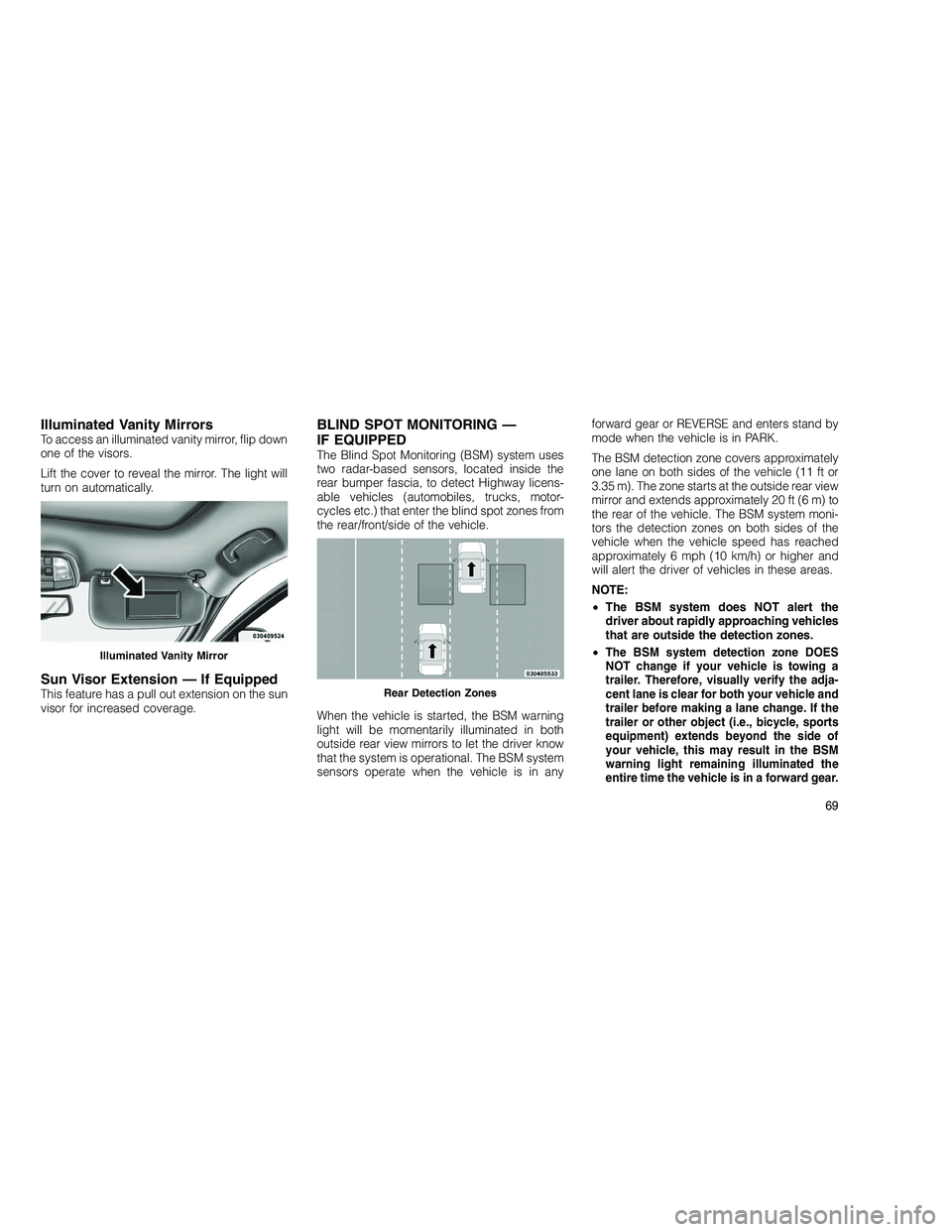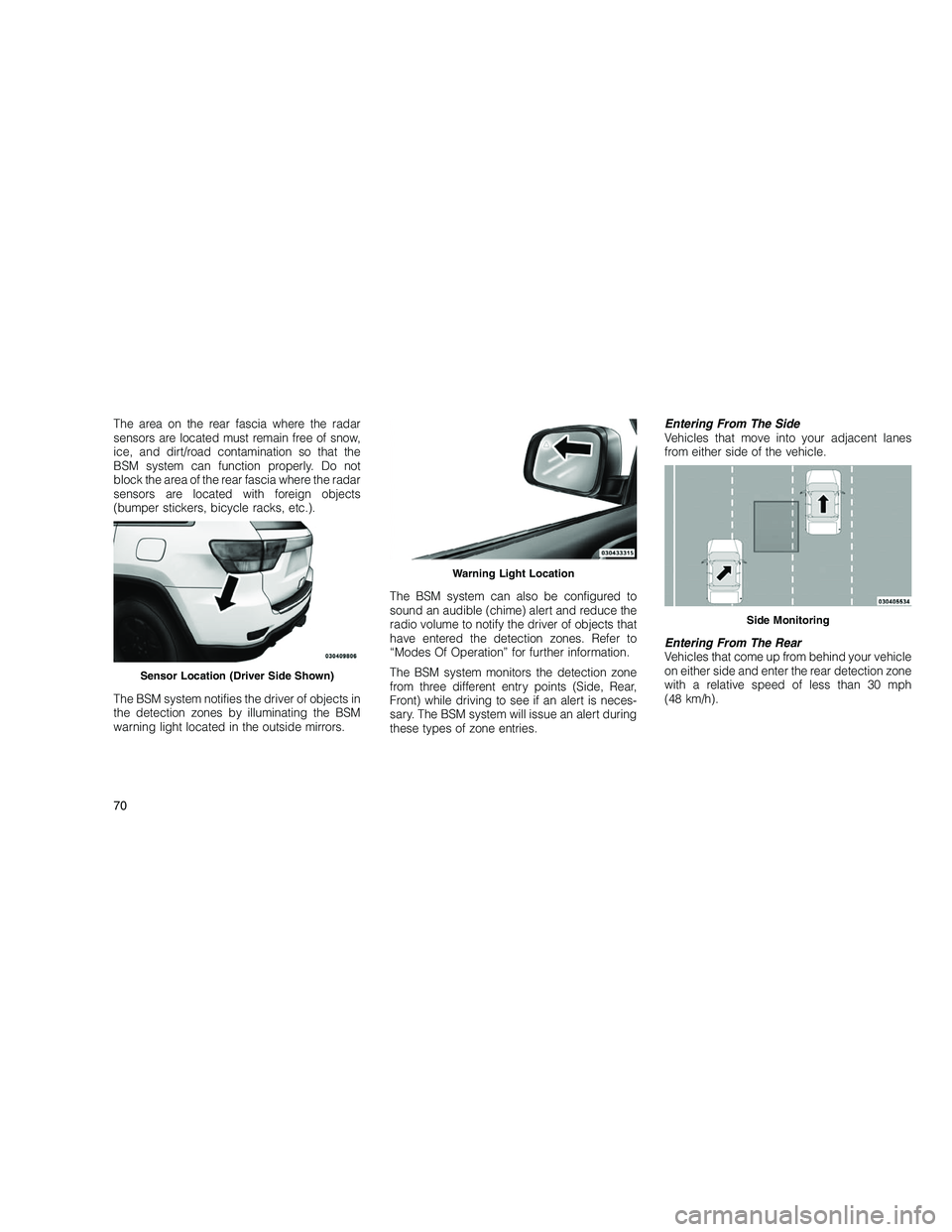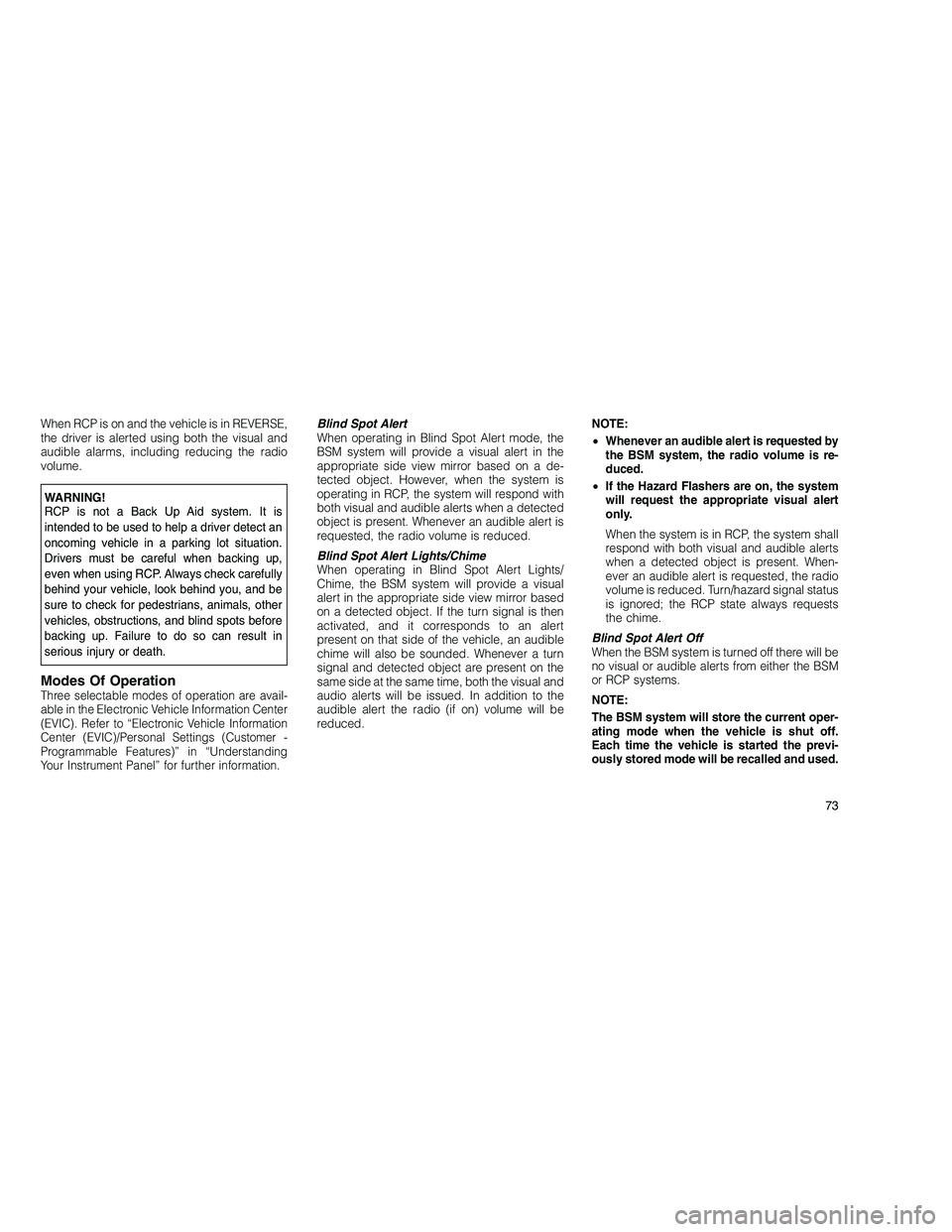2011 JEEP GRAND CHEROKEE warning light
[x] Cancel search: warning lightPage 49 of 350

Airbag Warning LightYou will want to have the airbags
ready to inflate for your protection
in a collision. The airbag system is
designed to be maintenance free,
if any of the following occurs, have
an authorized dealer service the
airbag system immediately.
• The Airbag Warning Light does not come on
during the four to eight seconds when the
ignition switch is first turned to the ON/RUN
position.
• The Airbag Warning Light remains on after
the four to eight-second interval.
• The Airbag Warning Light comes on intermit-
tently or remains on while driving. NOTE:
If the speedometer, tachometer, or any en-
gine related gauges are not working, the
Occupant Restraint Controller (ORC) may
also be disabled. The airbags may not be
ready to inflate for your protection. Promptly
check the fuse block for blown fuses. Refer
to the label located on the inside of the fuse
block cover for the proper airbag fuses. See
your authorized dealer if the fuse is good.
Event Data Recorder (EDR)This vehicle is equipped with an event data
recorder (EDR). The main purpose of an EDR is
to record, in certain crash or near crash-like
situations, such as an air bag deployment or
hitting a road obstacle, data that will assist in
understanding how a vehicle’s systems per- formed. The EDR is designed to record data
related to vehicle dynamics and safety systems
for a short period of time, typically 30 seconds
or less. The EDR in this vehicle is designed to
record such data as:
•
How various systems in your vehicle were
operating;
• Whether or not the driver and passenger
safety belts were buckled/fastened;
• How far (if at all) the driver was depressing
the accelerator and/or brake pedal; and,
• How fast the vehicle was traveling.
These data can help provide a better under-
standing of the circumstances in which crashes
and injuries occur.
45
Page 60 of 350

Safety Checks You Should Make
Inside the Vehicle
Seat Belts
Inspect the belt system periodically, checking
for cuts, frays, and loose parts. Damaged parts
must be replaced immediately. Do not disas-
semble or modify the system.
Front seat belt assemblies must be replaced
after a collision. Rear seat belt assemblies must
be replaced after a collision if they have been
damaged (i.e., bent retractor, torn webbing,
etc.). If there is any question regarding belt or
retractor condition, replace the belt.Airbag Warning Light
The light should come on and remain on for four
to eight seconds as a bulb check when the
ignition switch is first turned ON. If the light is
not lit during starting, see your authorized
dealer. If the light stays on, flickers, or comes
on while driving, have the system checked by
an authorized dealer.
Defroster
Check operation by selecting the defrost mode
and place the blower control on high speed.
You should be able to feel the air directed
against the windshield. See your authorized
dealer for service if your defroster is inoper-
able.Floor Mat Safety Information
Always use floor mats designed to fit the foot
well of your vehicle. Use only floor mats that
leave the pedal area unobstructed and that are
firmly secured so that they cannot slip out of
position and interfere with the pedals or impair
safe operation of your vehicle in other ways.
WARNING!
Pedals that cannot move freely can cause
loss of vehicle control and increase the risk of
serious personal injury.
•
Always make sure that floor mats are prop-
erly attached to the floor mat fasteners.
• Never place or install floor mats or other
floor coverings in the vehicle that cannot be
properly secured to prevent them from
moving and interfering with the pedals or
the ability to control the vehicle.
(Continued)
56
Page 61 of 350

WARNING!(Continued)
• Never put floor mats or other floor cover-
ings on top of already installed floor mats.
Additional floor mats and other coverings
will reduce the size of the pedal area and
interfere with the pedals.
• Check mounting of mats on a regular basis.
Always properly reinstall and secure floor
mats that have been removed for cleaning.
• Always make sure that objects cannot fall
into the driver foot well while the vehicle is
moving. Objects can become trapped un-
der the brake pedal and accelerator pedal
causing a loss of vehicle control.
(Continued)WARNING!(Continued)
• If required, mounting posts must be prop-
erly installed, if not equipped from the fac-
tory.
Failure to properly follow floor mat installation
or mounting can cause interference with the
brake pedal and accelerator pedal operation
causing loss of control of the vehicle.
Periodic Safety Checks You Should
Make Outside the Vehicle
Tires
Examine tires for excessive tread wear and
uneven wear patterns. Check for stones, nails,
glass, or other objects lodged in the tread.
Inspect the tread and sidewall for cuts and
cracks. Check the wheel nuts for tightness.
Check the tires (including spare) for proper
pressure. Lights
Have someone observe the operation of exte-
rior lights while you work the controls. Check
turn signal and high beam indicator lights on
the instrument panel.
Door Latches
Check for positive closing, latching, and lock-
ing.
Fluid Leaks
Check area under vehicle after overnight park-
ing for fuel, engine coolant, oil, or other fluid
leaks. Also, if gasoline fumes are detected or if
fuel, power steering fluid, or brake fluid leaks
are suspected, the cause should be located
and corrected immediately.
57
Page 71 of 350

MIRRORS
Inside Day/Night Mirror
A single ball joint mirror is provided in the
vehicle. It is a twist on mirror that has a fixed
position. The mirror head can be adjusted up,
down, left, and right for various drivers. The
mirror should be adjusted to center on the view
through the rear window.
Headlight glare from vehicles behind you can
be reduced by moving the small control under
the mirror to the night position (toward the rear
of the vehicle). The mirror should be adjusted
while set in the day position (toward the wind-
shield).
Automatic Dimming Mirror —
If Equipped
This mirror automatically adjusts for headlight
glare from vehicles behind you. You can turn
the feature on or off by pressing the button at
the base of the mirror. A light in the button will
illuminate to indicate when the dimming feature
is activated. The mirror is twisted on the wind-
shield button counterclockwise and requires no
tools for mounting.
CAUTION!
To avoid damage to the mirror during clean-
ing, never spray any cleaning solution directly
onto the mirror. Apply the solution onto a clean
cloth and wipe the mirror clean.
Outside MirrorsTo receive maximum benefit, adjust the outside
mirrors to center on the adjacent lane of traffic
with a slight overlap of the view obtained on the
inside mirror.
WARNING!
Vehicles and other objects seen in the pas-
senger side convex mirror will look smaller
and farther away than they really are. Relying
too much on your passenger side convex
mirror could cause you to collide with another
vehicle or other object. Use your inside mirror
when judging the size or distance of a vehicle
seen in the passenger side convex mirror.
Some vehicles will not have a convex passen-
ger side mirror.
Adjusting Rearview Mirror
Automatic Dimming Mirror
67
Page 73 of 350

Illuminated Vanity MirrorsTo access an illuminated vanity mirror, flip down
one of the visors.
Lift the cover to reveal the mirror. The light will
turn on automatically.
Sun Visor Extension — If EquippedThis feature has a pull out extension on the sun
visor for increased coverage.
BLIND SPOT MONITORING —
IF EQUIPPED
The Blind Spot Monitoring (BSM) system uses
two radar-based sensors, located inside the
rear bumper fascia, to detect Highway licens-
able vehicles (automobiles, trucks, motor-
cycles etc.) that enter the blind spot zones from
the rear/front/side of the vehicle.
When the vehicle is started, the BSM warning
light will be momentarily illuminated in both
outside rear view mirrors to let the driver know
that the system is operational. The BSM system
sensors operate when the vehicle is in anyforward gear or REVERSE and enters stand by
mode when the vehicle is in PARK.
The BSM detection zone covers approximately
one lane on both sides of the vehicle (11 ft or
3.35 m). The zone starts at the outside rear view
mirror and extends approximately 20 ft (6 m) to
the rear of the vehicle. The BSM system moni-
tors the detection zones on both sides of the
vehicle when the vehicle speed has reached
approximately 6 mph (10 km/h) or higher and
will alert the driver of vehicles in these areas.
NOTE:
•
The BSM system does NOT alert the
driver about rapidly approaching vehicles
that are outside the detection zones.
•
The BSM system detection zone DOES
NOT change if your vehicle is towing a
trailer. Therefore, visually verify the adja-
cent lane is clear for both your vehicle and
trailer before making a lane change. If the
trailer or other object (i.e., bicycle, sports
equipment) extends beyond the side of
your vehicle, this may result in the BSM
warning light remaining illuminated the
entire time the vehicle is in a forward gear.Illuminated Vanity Mirror
Rear Detection Zones
69
Page 74 of 350

The area on the rear fascia where the radar
sensors are located must remain free of snow,
ice, and dirt/road contamination so that the
BSM system can function properly. Do not
block the area of the rear fascia where the radar
sensors are located with foreign objects
(bumper stickers, bicycle racks, etc.).
The BSM system notifies the driver of objects in
the detection zones by illuminating the BSM
warning light located in the outside mirrors.The BSM system can also be configured to
sound an audible (chime) alert and reduce the
radio volume to notify the driver of objects that
have entered the detection zones. Refer to
“Modes Of Operation” for further information.
The BSM system monitors the detection zone
from three different entry points (Side, Rear,
Front) while driving to see if an alert is neces-
sary. The BSM system will issue an alert during
these types of zone entries.Entering From The Side
Vehicles that move into your adjacent lanes
from either side of the vehicle.
Entering From The Rear
Vehicles that come up from behind your vehicle
on either side and enter the rear detection zone
with a relative speed of less than 30 mph
(48 km/h).
Sensor Location (Driver Side Shown)
Warning Light Location
Side Monitoring
70
Page 75 of 350

Overtaking Traffic
If you pass another vehicle slowly (with a
relative speed less than 10 mph (16 km/h) and
the vehicle remains in the blind spot for ap-
proximately 1.5 seconds, the warning light will
be illuminated. If the difference in speed be-
tween the two vehicles is greater than 10 mph
(16 km/h), the warning light will not illuminate.The BSM system is designed not to issue an
alert on stationary objects such as guardrails,
posts, walls, foliage, berms, etc. However, oc-
casionally the system may alert on such ob-
jects. This is normal operation and your vehicle
does not require service.
Rear MonitoringOvertaking/Approaching
Overtaking/Passing
Stationary Objects
71
Page 77 of 350

When RCP is on and the vehicle is in REVERSE,
the driver is alerted using both the visual and
audible alarms, including reducing the radio
volume.
WARNING!
RCP is not a Back Up Aid system. It is
intended to be used to help a driver detect an
oncoming vehicle in a parking lot situation.
Drivers must be careful when backing up,
even when using RCP. Always check carefully
behind your vehicle, look behind you, and be
sure to check for pedestrians, animals, other
vehicles, obstructions, and blind spots before
backing up. Failure to do so can result in
serious injury or death.
Modes Of OperationThree selectable modes of operation are avail-
able in the Electronic Vehicle Information Center
(EVIC). Refer to “Electronic Vehicle Information
Center (EVIC)/Personal Settings (Customer -
Programmable Features)” in “Understanding
Your Instrument Panel” for further information.
Blind Spot Alert
When operating in Blind Spot Alert mode, the
BSM system will provide a visual alert in the
appropriate side view mirror based on a de-
tected object. However, when the system is
operating in RCP, the system will respond with
both visual and audible alerts when a detected
object is present. Whenever an audible alert is
requested, the radio volume is reduced.
Blind Spot Alert Lights/Chime
When operating in Blind Spot Alert Lights/
Chime, the BSM system will provide a visual
alert in the appropriate side view mirror based
on a detected object. If the turn signal is then
activated, and it corresponds to an alert
present on that side of the vehicle, an audible
chime will also be sounded. Whenever a turn
signal and detected object are present on the
same side at the same time, both the visual and
audio alerts will be issued. In addition to the
audible alert the radio (if on) volume will be
reduced.NOTE:
•
Whenever an audible alert is requested by
the BSM system, the radio volume is re-
duced.
• If the Hazard Flashers are on, the system
will request the appropriate visual alert
only.
When the system is in RCP, the system shall
respond with both visual and audible alerts
when a detected object is present. When-
ever an audible alert is requested, the radio
volume is reduced. Turn/hazard signal status
is ignored; the RCP state always requests
the chime.
Blind Spot Alert Off
When the BSM system is turned off there will be
no visual or audible alerts from either the BSM
or RCP systems.
NOTE:
The BSM system will store the current oper-
ating mode when the vehicle is shut off.
Each time the vehicle is started the previ-
ously stored mode will be recalled and used.
73